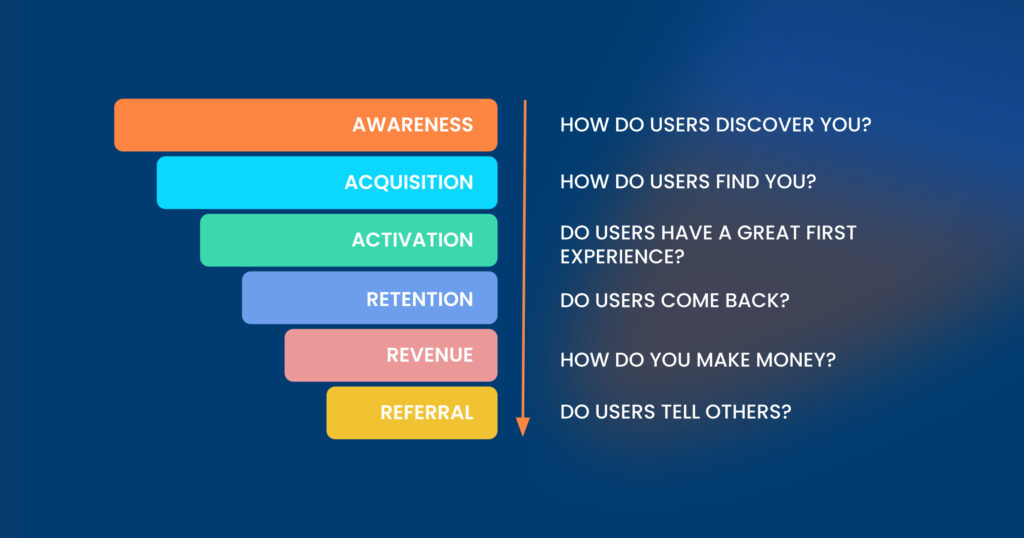Ever felt swamped in the bustling world of startups, searching for a clear direction? Let’s illuminate that path with the AAARRR framework.
Beyond its catchy name, it represents the pillars of success: Awareness, Acquisition, Activation, Retention, Retention, Revenue, and Referral.

If you’re a startup founder or a growth marketer, think of this as your strategic blueprint. With a metric-driven mindset, every decision becomes more informed and every strategy more precise.
Curious about how these marketing campaign metrics can redefine your approach? Let’s dive in and explore together.
Brand Awareness Expansion
In the digital age, brand awareness isn’t just billboards and TV spots. It’s a multifaceted endeavor requiring keen attention to key marketing metrics.

Let’s explore how to expand your brand’s footprint in the market effectively.
The Pulse of Recognition: Brand Metrics Unveiled
- Search Volume Insights: Did you know that brand search volume can lead to increased sales? Tracking your brand’s search volume over time allows you to gauge the growing interest and adjust your strategies accordingly.
- Direct Traffic Dynamics: A surge in direct traffic to your website is a clear indicator of brand recall. It’s like having repeat customers in a store; they know where to find you without any detours.
- Brand Mentions: Tools like Brandwatch or Mention can help you monitor the spread and impact of your brand across various platforms. It’s like eavesdropping on a global conversation about your brand.
- Social Media Hashtags: Analyzing the engagement level and reach of brand-related hashtags can offer insights into your brand’s social media influence. Think of it as the digital version of word-of-mouth.
- Industry Directories: Ever checked where your brand stands in industry-specific directories and listings? It’s time to see how visible you are in places where your potential customers might be looking for you.
Public Sentiment: The Heartbeat of Your Brand
Understanding public sentiment is akin to taking your brand’s pulse. It’s not just about numbers; it’s about emotions, perceptions, and narratives.
- Sentiment Analysis: Tools like Sentiment Analyzer can provide a snapshot of public perception. A positive sentiment score post-campaign can be a testament to its success.
- Customer Reviews: With more and more people trusting online reviews as much as personal recommendations, tracking reviews across platforms becomes crucial.
- User-generated Content: Engaging with content created by your users can offer invaluable insights. It’s a window into their world, their experiences with your brand.
- Feedback Loop: Collaborate with your customer service and marketing team. Their daily interactions can offer insights into your target audience’s sentiments and emerging issues.
Content Engagement Metrics:
- CMO Survey Insights: In an early 2023 survey, 43% of U.S. CMOs highlighted content engagement as a frequently measured metric. This emphasizes its growing importance alongside sales and digital performance.
- Depth of Interaction: Content engagement reveals the depth and quality of consumers’ interactions with a brand’s content. It’s not just about views but about meaningful interactions.
Competitive Positioning: Where Do You Stand?
In the grand chessboard of business, understanding your position relative to your competitors can be a game-changer.
- Share of Voice (SOV): It’s essential to know your brand’s SOV. If your competitors are dominating the conversation, it’s time to rethink your strategy.
- Competitor Sentiment Analysis: By analyzing competitor brand mentions and sentiment, you can gauge your brand’s relative standing. Are you the industry’s darling or the underdog?
- Digital Presence: Tools like SEMrush can help you track your digital presence versus your competitors. It’s like measuring your territory in the digital landscape.
- Backlink Analysis: Backlinks are like the roads leading to your brand. You can understand your referral traffic and industry authority by studying your backlink profile.
- PR Impact: Evaluating your PR efforts can help you understand how they enhance your brand positioning. Remember, in the world of branding, perception often trumps reality.
Navigating Acquisition Metrics
Acquisition is the lifeblood of any startup. But how do you know if your marketing efforts are paying off?

Let’s dive deep into the metrics that matter, ensuring every effort counts and every dollar is well spent.
Traffic Source Analysis: The Four Pillars
- Organic Traffic: The silent validators. These are the users who find you naturally through search engines. But how has this number evolved? Tracking the growth of brand search volume over time can offer insights.
- Paid Traffic: Your investments in the spotlight. Are they yielding the desired results? Analyzing the cost-effectiveness of your paid campaigns is essential.
- Referral Traffic: The power of word-of-mouth and backlinks. But is the quality up to the mark?
- Social Media Traffic: The buzz creators. Social platforms can be a goldmine, but it’s vital to ensure the website traffic is genuine and engaged.
User Growth Metrics: Numbers That Speak Volumes
The Pulse
Monitoring Daily Active Users (DAUs) and Monthly Active Users (MAUs) gives a real-time snapshot of engagement.
The Momentum
Evaluating the New User Growth Rate can be a reality check. Is your user base expanding at the pace you envisioned?
The Spark
Understanding the Activation Rate can be a game-changer. It’s not just about acquiring users but making sure they’re active and involved.
Cost Evaluation: Making Every Penny Count
Breaking down the costs can sometimes feel like a daunting task. But here’s a simplified approach:
- CPA & CAC: These aren’t just acronyms. They’re the metrics that determine the health of your acquisition strategies. Are you spending more than you should?
- ROI Check: Assessing the ROI of different acquisition strategies can be the compass guiding your future investments.
- Optimization Opportunities: Where can you cut corners without compromising quality? Identifying these areas can lead to significant savings.
Remember, in the world of startups, it’s not just about making noise; it’s about making the right kind of noise.
And these metrics? They’re your soundboard.
Mastering Activation Metrics
Activation is the bridge between a user’s initial interest and their commitment to your platform or product.

But how do you ensure they cross that bridge? Activation metrics provide the insights to guide them every step of the way.
User Interaction Metrics: The Heartbeat of Engagement
Click-Through Rate (CTR) & Conversion Rate
These are the pulse of your campaigns. A high CTR is promising, but if the Conversion Rate doesn’t align, there’s a gap to bridge.
Across all industries, the average CTR for AdWords is 3.17% on the search network and a notably lower 0.46% on the display network.
How do your figures compare?
Page Views & Time on Page
Dive into user behavior. Are they merely passing by or deeply engaging with your content?
CTAs and Landing Pages
Your gateways to action. Their effectiveness can be the difference between a user’s fleeting visit and a meaningful interaction.
Remember, a well-crafted and personalized CTA can perform 202% better than those that are basic.
Onboarding Efficiency: Crafting the Perfect Welcome
- The Onboarding Process: Your user’s first experience. Is it intuitive, captivating, and clear?
- Average Session Duration: During onboarding, this metric is a beacon of user engagement. The longer they linger, the more they’re likely to connect with your offering.
- Onboarding Funnels: Track the journey. How many users reach the intended destination, and where might they be veering off course?
Customer Feedback Loops: Turning Insights into Action
- Feedback Collection: Direct from users. What’s resonating, and where are the stumbling blocks?
- Voice of the Customer (VoC): Structured, actionable insights. VoC isn’t just about gathering feedback; it’s about transforming it into tangible improvements.
- Addressing Concerns: Listening is half the battle. Acting on user feedback not only addresses their concerns but can significantly boost activation rates.
With activation, it’s about ensuring every user touchpoint is an invitation to explore further.
And with these marketing metrics as your guide, you’re poised to create an experience that’s not just memorable but irresistibly engaging.
Harnessing Retention Metrics
In the bustling world of startups, the acquisition might be the exciting first date, but retention? That’s the long-term relationship, the true testament to your product’s value and appeal. Let’s dive deeper.
For starters, the User Retention Analysis is pivotal. By calculating the Monthly Active User (MAU) Retention Rate, you get a clear picture of how many users are sticking around month after month.

But it’s also essential to keep an eye on the flip side: the churn. Analyzing Days to Churn and Active Churn Rate can offer insights into when and why users decide to part ways.
Armed with this knowledge, you can craft retention strategies tailored to user behaviors, ensuring they feel valued and understood.
But what about their overall satisfaction? Enter the Customer Satisfaction and Loyalty metrics. Tools like the Customer Satisfaction Score (CSAT) and the Net Promoter Score (NPS) act as thermometers, gauging the warmth of your users’ feelings towards your product.
And in this age of instant feedback, monitoring social media engagement rates can provide real-time insights, allowing you to pivot and adapt swiftly.
Lastly, there’s the concept of Product Stickiness. It’s one thing for users to like your product, but are they truly engaged? By measuring product stickiness, you can discern how often users return.
Delving into feature usage patterns can spotlight which aspects of your product are the true crowd-pleasers and which might need a little more polish.
Revenue Metrics Proficiency
Revenue metrics are the lifeblood of any business, acting as a clear indicator of growth, sustainability, and overall health.

But in the intricate dance of numbers, which ones truly capture the essence of a startup’s financial trajectory? Let’s delve into the metrics that paint the most vivid picture.
Revenue Growth Analysis
Its ability to generate consistent revenue is at the heart of any business’s success. By keeping a close eye on the Monthly Recurring Revenue (MRR) and the Revenue Growth Rate, you get a pulse on the financial rhythm of your startup.
But it’s not just about the total revenue; understanding the Average Revenue Per User (ARPU) can offer insights into each user’s value.
And, of course, the efficiency of your monetization strategies plays a pivotal role. Are your revenue streams as effective as they could be?
Customer Lifetime Value (CLV) Analysis
Beyond the immediate revenue lies the potential for long-term customer relationships. The Customer Lifetime Value (CLV) isn’t just a number; it’s a reflection of the sustained value a customer brings over time.
But what factors contribute to a higher CLV? Is it product quality, customer service, or perhaps a blend of both?
By identifying these elements, you can craft strategies that not only retain customers but also maximize their lifetime value.
Return on Investment (ROI) Evaluation
In the world of startups, every dollar spent is an investment. But are you getting the desired returns? Measuring the ROI of marketing campaigns can shed light on the effectiveness of your strategies. It’s also crucial to analyze the potency of different revenue streams.
Where’s the bulk of your revenue coming from, and are there untapped avenues? And, of course, optimizing marketing ad spend is the key to ensuring that every dollar works as hard as it possibly can for your business.
Referral Metrics Mastery
Referral metrics shine a light on how often your happy customers are spreading the word. It’s all about seeing who’s cheering for you and how loudly they’re doing it!

- Referral Rate: See how many of your users are raving about you to their friends. A high rate? You’re clearly doing something right!
- Number of Referrals: This is your scoreboard. How many have come your way thanks to a friend’s nudge?
- Referral Conversion Rate: It’s one thing to hear about you, another to join the party. This shows how many actually did.
- Lifetime Value of a Referred Customer (LTVRC): Referred friends aren’t just numbers—they have value. This tells you how much.
- Referral Source Breakdown: Are friends chatting about you at brunch or online? Find out where your praises are being sung.
- Cost per Referral Acquisition: There’s often a thank you note (or discount) for bringing a friend. This metric counts those costs.
- Viral Coefficient: If one user brings more than one friend, you’re in the spotlight. This tells you how big that spotlight is.
- Referral Program Engagement: Not everyone talks, but some shout from the rooftops. This shows how many are shouting about you.
- Referral Feedback Loop: New friends have fresh perspectives. Listen to theirs to keep the referral train chugging along.
The word-of-mouth journey is a powerful one. With these insights, you’re ready to harness its full potential.
Bonus: Embracing Resurrection Metrics
Ever heard of the marketing Phoenix? No, it’s not a mythical creature, but the art of bringing back users who’ve drifted away.

Welcome to the world of Resurrection Metrics, where we rekindle old flames and reignite passion. Ready to dive in?
Reactivation Campaign Effectiveness
Ping! That’s an old user coming back. But how do we make sure they stay this time?
- Monitoring the Success of Reactivation Campaigns: It’s not just about sending a message; it’s about seeing its ripple effect. Are they clicking? Returning? Let’s find out.
- Analyzing the Behavior of Reactivated Users: Once they’re back, what are they doing? Which features or pages are they interacting with? This insight can guide future digital marketing campaigns.
- Identifying the Channels that Drive the Highest Reactivation Rates: Not all marketing channels are created equal. Some might be your golden ticket to re-engagement. Time to discover which ones.
Customer Feedback on Resurrection Efforts
Ever wondered, “What made you come back?” Let’s ask them directly!
- Collecting and Analyzing Feedback from Returning Users: Their insights are gold. Understand their reasons to tailor your approach better next time.
- Utilizing VoC to Identify What Enticed Users to Return: Voice of the Customer (VoC) is the compass pointing to what your users truly want.
- Creating Tailored Re-engagement Campaigns Based on User Feedback: Personalization is key. Craft campaigns that resonate based on real feedback.
Analyzing Resurrection Impact on Business Metrics
The big question: Is all this effort worth it?
- Assessing How Reactivation Efforts Affect Retention and Revenue Metrics: It’s not just about numbers but engagement quality. Are resurrected users sticking around longer? Spending more?
- Evaluating the Long-term Value of Resurrected Users: Beyond the initial return, what’s the prolonged impact of these users on your business?
- Analyzing the Cost-effectiveness of Resurrection Strategies: Return on investment is crucial. Ensure your re-engagement efforts are not just effective but also efficient.
Beyond AAARRR: Innovative and Fresh Metrics
In the dynamic landscape of growth marketing, the AAARRR metrics have been our trusty compass.
But as the terrain of marketing evolves, so should our tools. Imagine having a magnifying glass that reveals more than usual.

Ready to explore these new metrics? Let’s venture beyond the familiar.
Brand Health Metrics
After launching a marketing campaign, one of the first questions to ask is: Did we make an impression? This is where the Brand Awareness Lift comes in. For instance, if you launched a new ad campaign, did online searches for your brand increase?
Then, as days turn into weeks, it’s essential to feel the pulse of your brand’s reputation. The Brand Sentiment Score is like a mood ring for your brand. If you released a new eco-friendly product line, are consumers praising your efforts or pointing out flaws?
Lastly, amidst the cacophony of brands vying for attention, how loud is your brand’s voice? Brand Share of Voice can tell you. If there are ten conversations about eco-friendly products, how often is your brand mentioned compared to competitors?
Employee and Partner Engagement
Behind every successful brand are its champions: the employees and partners. The Employee Net Promoter Score (eNPS) is a simple yet powerful metric.
Think of it as asking your marketing teams, Would you recommend working here to a friend? A high eNPS can be a testament to a positive work environment, while a low score might hint at underlying issues.
But it’s not just about those within the company. Partnerships can be the wind beneath a brand’s wings. Regularly checking in on partner satisfaction and engagement can provide insights.
For example, if you collaborate with a supplier, are they happy with the communication and mutual growth?
Future-Forward Metrics
The horizon of marketing is ever-expanding. New metrics emerge, offering fresh perspectives. For instance, as AI and analytics become more intertwined, we can anticipate consumer needs even before they do.
Imagine knowing that a segment of your users might be interested in eco-friendly products even before they search for them.
In this evolving landscape, it’s crucial to foster a culture of continuous learning. Embrace the new, but also cherish the lessons from the old.
After all, in the world of metrics, both the compass and the magnifying glass have their place.
Navigating Tomorrow: Your Metric Compass Awaits

From the foundational AAARRR metrics to the uncharted territories of brand health and future-forward metrics, we’ve journeyed together through the expansive landscape of growth marketing. Each metric is a beacon, illuminating paths to informed decisions and robust growth.
Let these insights be your compass as you stand at the helm of your brand’s future. Embrace them, act on them, and watch your brand soar to new heights.
Ready to set sail? The horizon of opportunity beckons.

